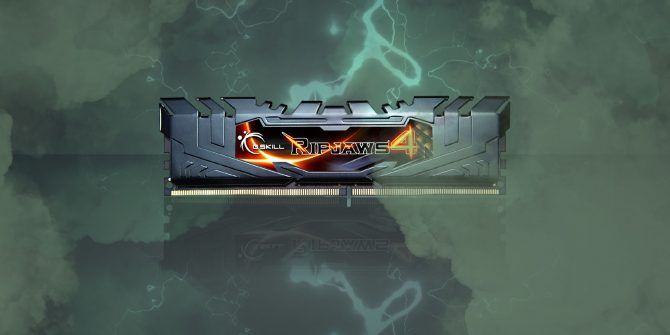RAM (Random Access Memory) is one of the basic components of a computer or a smartphone. But there are many misconceptions about RAM, like whether you can mix RAM size or brands.
RAM’s job is to remember computations for a limited amount of time so that your processor does not need to redo those computations each time. But there are misunderstandings about using different sizes of RAM together. Does RAM have to match? Should you use the same speed RAM?
In this article, we’ll attempt to answer them all. Let’s bust some myths about RAM.
1. “You Can’t Mix RAM Sizes”
Most laptops or computers come with at least two slots for RAM sticks, if not more. Most modern motherboards will provide four RAM slots. There’s a prevailing misconception you cannot use different RAM sizes together or that you cannot mix RAM brands.
Simply put, that’s not true. So, can you mix RAM brands or the size of your RAM sticks? The answer is Yes, you can mix RAM sticks and RAM sizes and even different RAM speeds—but mixing and matching RAM modules isn’t the best for system performance.
For the best system performance, it is advisable to use RAM sticks by the same manufacturer, of the same size, and of the same frequency. But there’s a simple reason behind why mixing RAM sizes is usually not the best way. RAM has several components that all come together to make it perform well.
Match Your RAM for the Best Performance
RAM works best when paired with matching hardware. For optimal performance, your RAM should use the same voltage, and their respective controllers should play well with each other and the motherboard. That’s why it’s best to use the same RAM model in all slots.
However, this doesn’t mean you can’t use different size RAM sticks together. For example, if your first stick is 4GB, you can still add a new 8GB stick. Once you switch on dual-channel mode (also called flex mode), it will perform as two 4GB sticks running side by side in optimal performance.
The remaining 4GB of the new stick will run in single-channel mode. Overall, it’s not as fast as using two sticks of the same size, but it’s still faster than what you had before.
It’s the same with frequency or speed. Your RAM sticks will work together at the frequency of the lower stick by default. So, do RAM sticks have to match? No, but it’s better if they do.
2. “I Don’t Need More RAM,” or “My System Has Enough RAM”
“This amount of RAM is enough to run the software. You don’t need extra,” is common advice you’ll find. Yes, it might be enough to run your apps, but that doesn’t mean it can’t be faster. More RAM helps, even if you use different size RAM together. That’s because of how programs are made.
Most developers write their programs so that the app requests a certain percentage of the RAM available. If you have more RAM installed, the same requested percentage will mean more size for the program.
Just because you’re using only 60 percent (or any small percentage) of your total RAM capacity, it doesn’t mean you don’t need more RAM. Your regular tasks might only request 60 percent of RAM, saving the rest for other tasks you might start in the future.
As a general thumb rule for computers, 4GB is the minimum and 8GB is the recommended size for best performance for regular users. Gamers, PC enthusiasts, and professionals who work with graphics, video, or sound should look for 16GB, while 32GB systems are becoming common. It all begs the question, how much RAM do you really need?
3. “RAM Size Is All That Matters”
You probably know how much RAM your phone or PC has. When someone says they have more RAM in their PC, you automatically assume their system runs faster. But that’s not necessarily true. The capacity or size of the RAM isn’t all that matters.
Among the determining factors of RAM performance are speed and frequency. Like with a CPU, RAM has clock speeds. The higher the clock speed, the more functions it can perform in a second. You’ll often find RAM sticks with 2400MHz or 3000MHz frequency, while 3200MHz and 3600MHz are now the norm for high-end systems.
One issue you can run into here is mismatched RAM speeds, affecting you in two ways.
First, if your RAM runs at 2000MHz but your motherboard only supports 1333MHz RAM, your system won’t use the 700MHz difference between the two speeds.
Second, if you mix RAM modules with different speeds, both sticks will run at the slowest module’s speed. So, if you had one stick of RAM running at 2400MHz and one running at 3600MHz, both sticks would run at the slower speed, wasting the faster RAM’s potential.
Generally speaking, the regular computer user won’t see much of a difference between 8GB and 16GB of RAM. However, changing it to a faster RAM of the same 8GB can lead to a significant boost. Depending on how you use your machine, you should figure out which is more important for you: faster RAM or more RAM?
4. “Clear Your RAM to Boost Its Speed”
The adage that you should clear your RAM to make it faster is one of the most persistent RAM myths of all. The idea that clearing your RAM makes it faster came about at the same time as snake-oil software like “RAM boosters” and “memory optimizers.”
In short, don’t clear your RAM. You want your RAM full of useful data to help keep your system processes fast.
The job of RAM isn’t to sit empty. In fact, your operating system and your software should be using up every little bit of RAM available. Freeing up RAM with one of those booster programs does nothing. If anything, it might actually slow down your system since “freeing up” means you are removing certain computations from the RAM’s memory.
RAM isn’t the same as your hard drive. RAM auto-manages the data it holds, adjusting to hold frequently accessed data. If you have 4GB of RAM, your system constantly writes, erases, and rewrites frequently accessed data in those 4GB.
That’s not to say constantly filling your RAM is a good thing. If you constantly fill your RAM, it can lead to other speed issues. Most modern operating systems use what is known as a paging file, also referred to as virtual memory. Your computer will begin pushing some data from the super-fast RAM into the much slower regular memory.
Virtual memory is really useful as it stops your computer from slowing to a crawl. However, if you frequently run out of RAM, it’s usually a sign that it’s time to purchase some higher-capacity RAM modules.
Back to the RAM clearing speed-boost myth. Don’t use RAM boosting or memory cleaning software. They don’t work. At best, they’re just a nuisance and a time-waste. At worst, you could introduce adware or scamware to your computer.
5. “You Must Use an Equal Number of RAM Sticks”
The final myth is that you must always use an equal number of RAM sticks. Like the first section on different sizes, you don’t have to use two or four or six RAM sticks. No, you can use one stick of RAM—hence why manufacturers make and retail single sticks of RAM.
You can also use three sticks of RAM if you want, but as above, it can come at the cost of overall performance. If you have two matching 8GB RAM sticks, they will run in dual-channel mode, providing the most efficient and effective system performance.
Now, say you have three sticks of 8GB RAM, boosting your total memory to 24GB. Great, right? Depending on your system configuration, the type of RAM you’re using, and your motherboard, introducing the third stick of RAM could disable the dual-channel RAM support for the first two sticks of RAM. So, while you have a larger capacity, your overall performance may drop.
You’ll find a lot of debate online regarding using an equal number of RAM sticks. You don’t have to use an equal number, but it can harm your overall system performance if you decide not to.
RAM Works Differently on Macs and iPhones
Apple has a different approach to RAM than PCs and Android phones, so many of the above rules go out the window. But don’t worry, we have excellent guides to explain the differences.
The iPhone’s base architecture is much different from Android. That’s why you won’t find Apple talking about how much RAM its iPhones have, while they’re still as fast as the best Android phones.
Unfortunately, not all Mac models allow you to upgrade your system RAM. For many Mac users, this is never an issue, but it can become an issue for some. If you’re running out of RAM, check out our guide on how to upgrade the RAM on your Mac.
Busting RAM Myths One at a Time
These five myths are the most common ones you’ll read regarding RAM.
You can do a lot with RAM: mismatched sticks, different speeds, different sizes, and so on. For the most part, you’ll just end up with a slower computer. Still, it is always best to match your RAM sticks. That way, you’ll receive the best performance available, and there is less chance of corruption or other issues arising from mismatched memory modules.
About The Author

